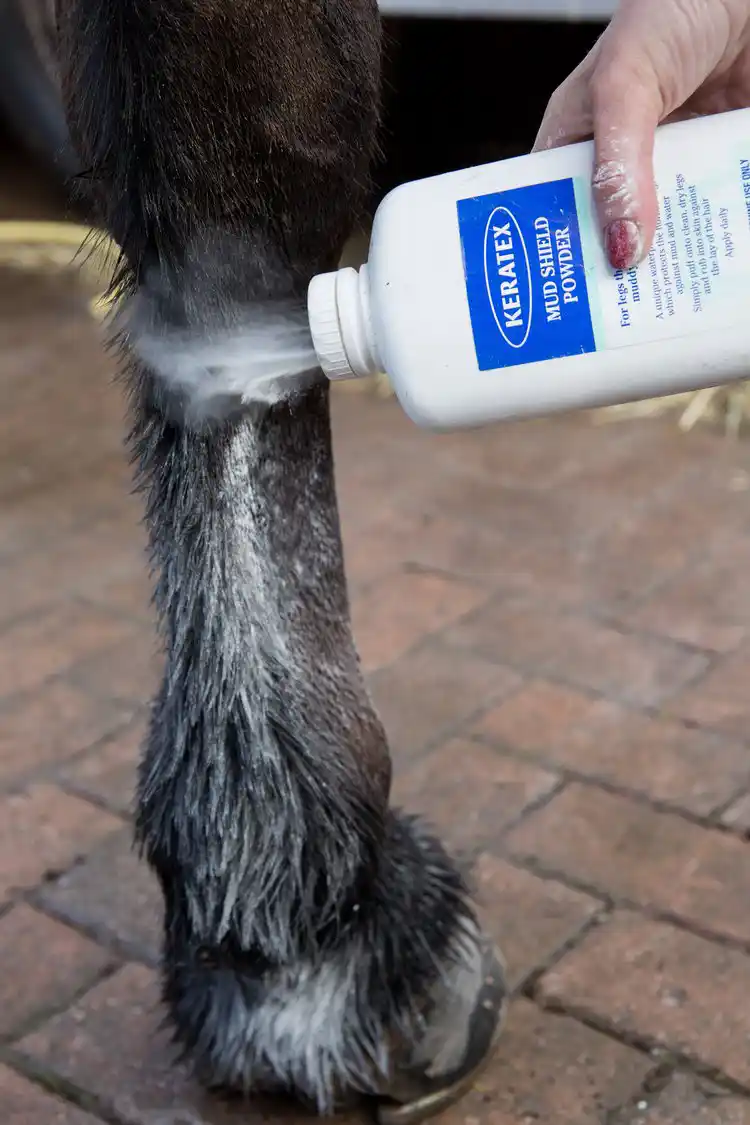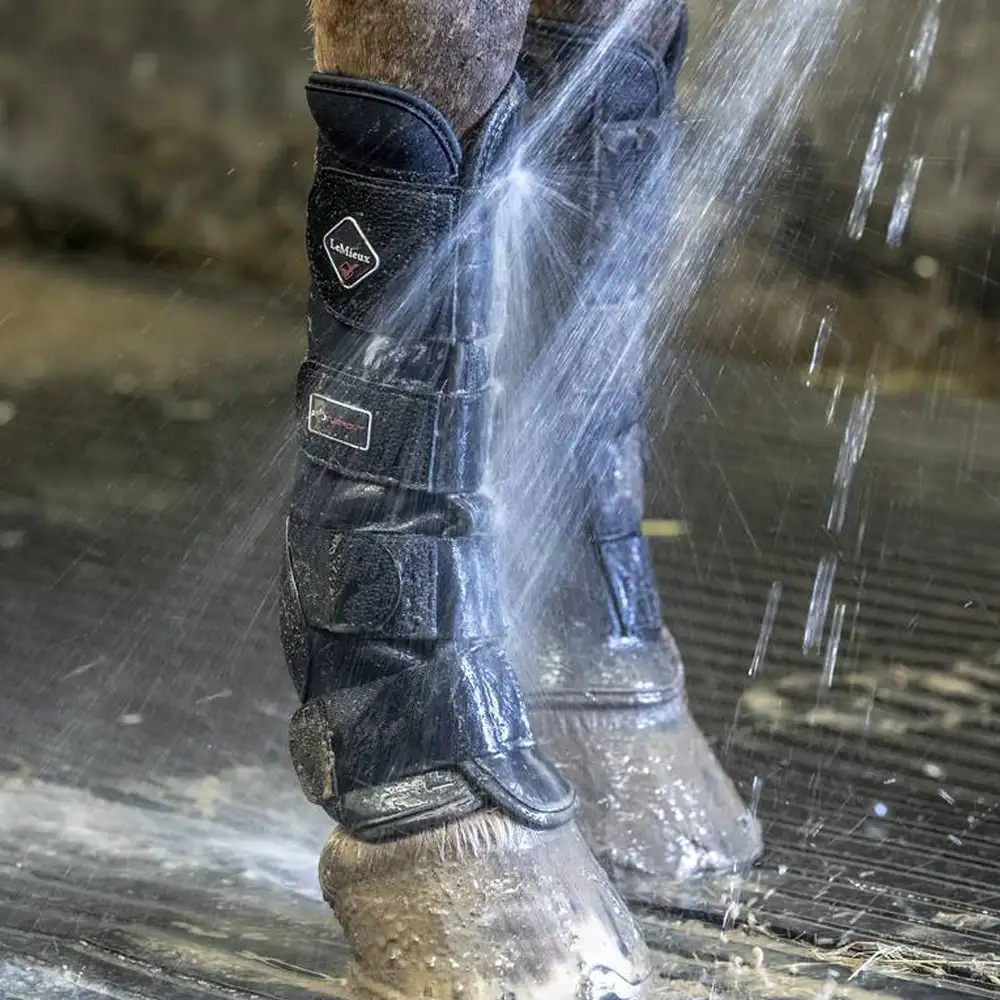Advice, Equine Posts
Winter Challenges for Horses: Understanding and Managing Mud Fever
During the chilly winter months, persistent rainy days have become a characteristic hallmark, leading to our equine companions often being confined to damp, muddy paddocks.
Unfortunately, this can heighten the likelihood of them grappling with the troublesome mud fever.
Also known as dermatitis, greasy heels, or cracked heels, this non-contagious skin condition primarily affects the lower limbs of horses, triggering irritation and discomfort.

Recognising the Signs
Mud fever, sometimes referred to as mud rash, commonly manifests as crusty scabs on the heels and lower legs, accompanied by broken or damaged skin, and matted hair or patches of hair loss exposing raw skin underneath.
A tell-tale creamy, white, yellow, or green discharge may be observed between the skin and the scabs, often accompanied by heat, pain, and swelling in the affected limb. In severe instances, lameness can also manifest as a symptom.
Left unattended, infections may fester beneath the scabs, leading to pronounced swelling of the leg.
Consequently, affected horses may display signs of sensitivity, avoiding any contact with the afflicted area.
Understanding the Root Causes
Mud fever typically arises due to bacterial invasion, a consequence of prolonged exposure to wet conditions that soften the skin, leaving it vulnerable to damage from the abrasive impact of mud.
Equines with thick feathers are particularly susceptible to leg mites, often exacerbated by relentless itching that can break the skin, creating an entry point for bacteria.
Owners suspecting leg mites are advised to seek guidance from their veterinarian promptly.

Identifying Risk Factors
Various factors contribute to compromised skin integrity in horses, rendering them susceptible to bacterial invasion and subsequent mud fever. These factors include:
- Prolonged exposure to muddy or wet conditions.
- Standing in unclean bedding.
- Frequent washing of the legs without thorough drying.
- Existing wounds or injuries, such as overreach injuries.
- Presence of sensitive, pink skin under white markings.
- Thin skin, commonly observed in breeds like Thoroughbreds or Arabs.
- Weakened immune systems, often secondary to underlying conditions such as Cushing’s Disease, rendering horses less capable of combating infections and prone to persistent health issues, including stubborn cases of mud fever.
Treatment Options
Timely intervention is crucial when mud fever is suspected, necessitating prompt consultation with a veterinarian for an accurate diagnosis and tailored treatment plan. Once a treatment regimen is prescribed, diligent management by the owner is imperative.
Primary treatment strategies often include:
- Providing dry, clean shelter to minimize further exposure to muddy conditions.
- Delicately removing scabs to facilitate improved access to the affected area and promote air circulation for enhanced healing. Caution is advised, as this process can be discomforting for the horse and might require sedation.
- Regular cleansing of the affected region using a mild disinfectant, followed by careful drying with a clean towel.
- Application of stable bandages to maintain cleanliness, offer support, and reduce potential swelling.
- Targeted treatment for leg mites or fungal infections, if they serve as the triggering factor for mud fever.
- In cases where horses possess thick feathers, careful clipping of hair from the lower legs might be necessary to improve air exposure and facilitate easier cleaning and treatment.
- Severe cases of mud fever may require repeated treatments and the application of specialised creams.
Consultation with the vet can help determine the best course of action. In complex scenarios, a blood test might be recommended to identify underlying ailments. A swab test can also be conducted to check for bacterial growth and sensitivity, guiding the need for antibiotic treatment.
Additionally, depending on the clinical signs and overall health of the horse, anti-inflammatories may be prescribed.

Understanding Potential Complications
Neglected mud fever can lead to more severe complications such as cellulitis and lymphangitis, both of which involve bacterial infections in the lower leg, affecting the blood vessels and lymphatic system, resulting in pronounced swelling and discomfort.
Consequently, prompt veterinary intervention is advised if any swelling is noticed, as these conditions tend to affect one leg at a time.
Preventive Measures
Several proactive strategies can significantly reduce the likelihood of mud fever in horses, all centred around averting the underlying causes.
These preventive measures include:
- Minimising prolonged exposure to wet, muddy conditions, ensuring horses have access to dry standing areas.
- Implementing effective grassland management techniques, including field rotation to reduce poaching and the strategic placement of hardcore in high-traffic areas.
- Refraining from washing the horse’s legs immediately after bringing them in from the field, opting instead to let mud dry and then gently brush it off with a soft-bristled brush. If washing is necessary, thorough drying with a clean, dry towel is essential.
- Utilising barrier creams before turnout to create a protective layer between the skin and the mud. However, caution must be exercised to apply them only on dry and clean skin to prevent the formation of a bacterial breeding ground.
- Exploring the use of specially designed turnout boots to prevent mud from reaching the horse’s legs, ensuring a proper fit to avoid potential rubbing and subsequent complications.
- Addressing underlying conditions promptly, including mites, fungal infections, or any existing wounds, to curtail their contribution to the onset of mud fever.
By understanding the nature of mud fever and adopting proactive management and preventive measures, horse owners can significantly reduce the likelihood of their equine companions grappling with this troublesome condition.
Regular vigilance, timely veterinary consultation, and careful adherence to treatment plans can go a long way in ensuring the well-being and comfort of these magnificent animals during the challenging winter season.










